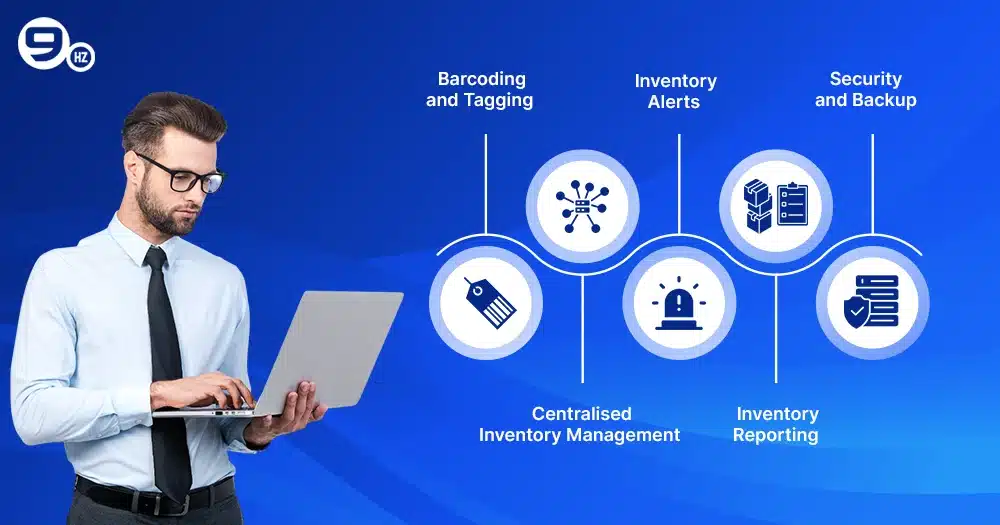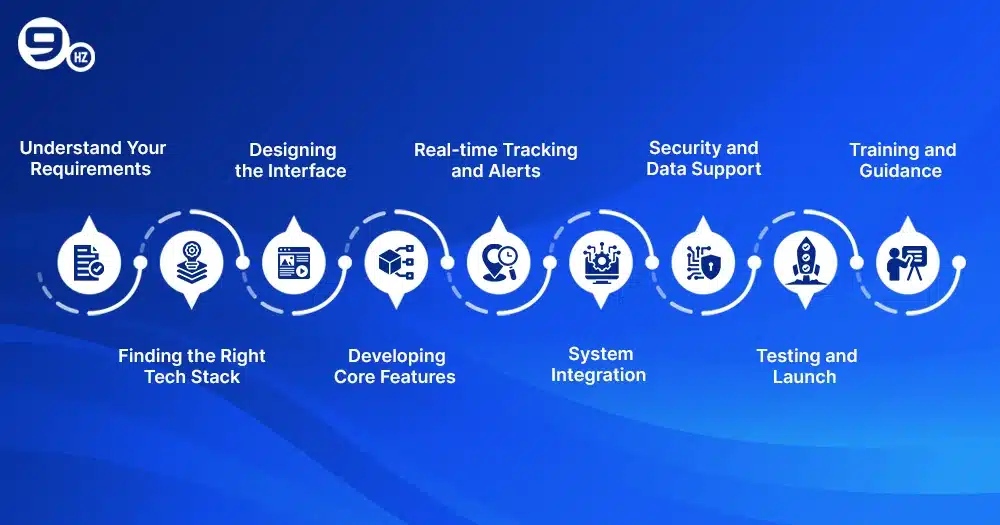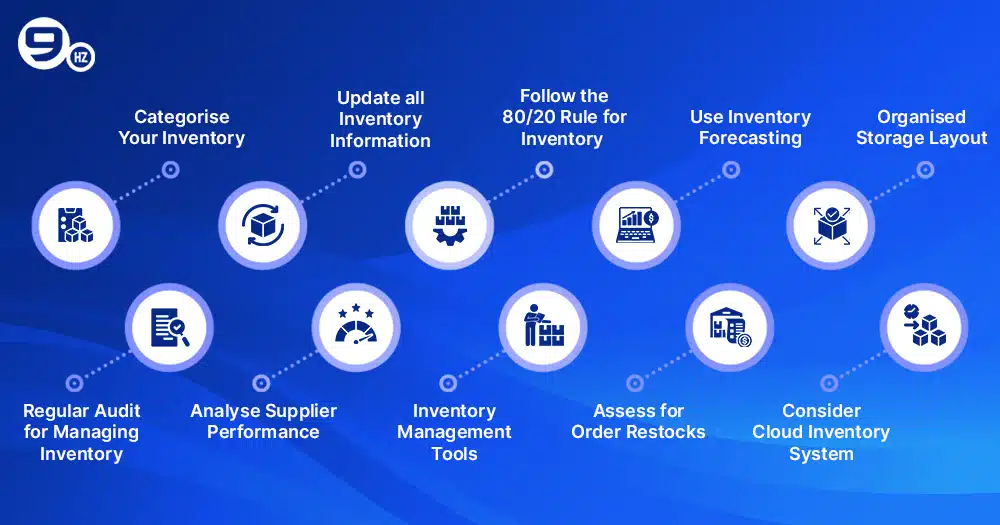Whether your business stores inventory at a warehouse, retail store, or manufacturing unit, managing your inventory is the backbone of your business as it can directly impact customer demand and profitability. In the digital business, every other company executes faster shipping orders, bearing the risk of order cancellations and insufficient inventory. According to Capgemini, more than 74% of businesses have experienced shipment delays and longer lead times. Also, more than 70% of retailers are in favour of integrating an automated inventory system with sensors and analytics for real-time visibility, many are now asking, how to create an inventory system that addresses these challenges effectively.
Many businesses are hesitant to rely on third-party software due to data risks and prefer to build an inventory system that offers complete control over their supply chain operations. If you’re a tech-savvy company exploring inventory management software development, this detailed blog provides a step-by-step process and expert guidance to help you build a custom solution tailored to your needs.
What is an Inventory System?
It is a continuous process of tracking stock and supplies across the supply chain. The inventory system provides updated records for new and returned products as they enter the warehouse. This system captures core data related to inventory, including cost per unit, purchase dates, production dates, serial numbers, and number of units.
An inventory system helps businesses create work orders, bills of material, receipts, and other documentation to gain complete control over inventory levels. Modern-day inventory systems are integrated with technology, including the Internet of Things (IoT), Big Data, AI, and ML, which are geo-tagged and track inventory remotely.
Companies follow specific inventory system techniques based on their products. These might include the reorder point formula, economic order quantity (EOQ), minimum order quantity, dropshipping, consignment inventory, and lean manufacturing. Most inventory tools and software, like Zoho inventory, combine all these processes into one system for better optimization.
Key Features of an Effective Inventory System
Having the right inventory system can streamline processes for trading, sales, stock levels, orders, and deliverables. Whether you are managing product catalogues, raw materials, or warehouse inventory, integrating an inventory system with automated barcode scanning, real-time inventory updates, and order tracking plays a crucial role in developing effective supply chain management. Businesses looking to enhance these capabilities can benefit from tailored supply chain software development services that align technology with operational goals.
Here are the top features that you should integrate to build an inventory system:
Barcoding and Tagging
One of the essential features that reduces human errors in inventory management. It can fasten the data entry process by reducing time and resources. Traditionally, it takes hours to track all details till the inventory reaches the warehouse, but using barcode readers, it can be finished within a fraction of the time.
Centralised Inventory Management
The inventory system aims to integrate all scattered processes in one place, so this feature signifies that it can develop a centralized record system for product histories, stock levels, and item movements. This helps provide updated details across multiple channels and departments and streamlines collaboration for uniform inventory data.
Inventory Alerts
A modern inventory system sends automated alerts to update inventory operators on critical inventory levels. In case of high-demand sessions and low running times, it can automatically notify accountable parties. This proactive feature might save time on manual inspection and encourage strategic decision-making.
Inventory Reporting
A key feature of a real-time inventory reporting tool assists managers with up-to-date minute insights and generates reports with tracking stock progress, shipments, and delivery status details. Based on market demands, inventory complexities, or logistics challenges, this feature ensures operators can make informed decisions without any delays.
Security and Backup
Businesses aim to safeguard inventory data from cyber threats and unauthorised access ensure integrity. Besides security, the system offers backup solutions to prevent data loss, support operational resilience and continuity without any major disruptions. This feature makes an automated inventory system a reliable alternative.
How to Create the Inventory System? Step by Step
When it comes to inventory, businesses prefer to have complete control over their management. Although the market offers countless software options, they may not provide as much personalisation as creating your own inventory system. Here is step-by-step guidance on creating an inventory system:
Step 1: Understand Your Requirements
Before entering into the development stage, it is important to address major challenges for businesses related to inventory, its features, and how it can integrate with the existing system. Once you are prepared with this question, it will help to define your goals and guide the development process based on business needs.
Step 2: Finding the Right Tech Stack
Developing an inventory system with customisable features requires the right technologies to create inventory solutions that are exactly what you are looking for. For instance, NoSQL or SQL for databases, Ruby on Rails, Python, and Node.js for the backend, React, Angular, or Vue.js for the front end, and AWS, Google Cloud, or Azure for Cloud services.
Step 3: Designing the Interface
Integrating a user-friendly interface helps managers navigate features and control inventory management. The system has an intuitive interface, is easy to navigate, and features customised dashboards and reporting. It should be accessible on different devices, such as tablets, laptops, and mobiles.
Step 4: Developing Core Features
Inventory systems must require integrated features of inventory control, barcode and geo-tagging, product mapping, automate purchase orders, reorder points, demand forecasting, reporting, and analytics. So, developers should invest in developing core features using a tech stack that complements their inventory management parameters.
Step 5: Real-time Tracking and Alerts
Next, integrating tracking tools that reflect any changes into stock levels and automatically send alerts. It generates insights related to sales trends, reorder points, and stock levels. You can add tags to products and use barcode scanning for stock verification and inventory management.
Step 6: System Integration
For the basic version of your inventory system, you can integrate core features and real-time tracking tools to develop software. If you are looking for advanced-level optimisation, integrate other third-party ERP, CRM, eCommerce, and API support integrations that ensure data flow for multiple departments.
Step 7: Security and Data Support
Once you are done with the development stage, most businesses overlook security and data protection aspects. It is essential to implement data encryption, multi-factor authentication, role-based access controls, and regular audits for vulnerability checks. It helps to create an inventory system with more scalability and a lower risk of data threats.
Step 8: Testing and Launch
Before the launch of your customized inventory system, you should check on usability and feature enhancements. Schedule for beta testing with a small group of users, feedback loop, regular updates, and system optimisation with changing needs. Once beta testing shows positive results, you are all set for a perfect launch.
Step 9: Training and Guidance
Implementing an inventory system for stock management and optimization will be difficult without proper training and a guiding manual. You can create a comprehensive user training module, documentation, FAQs, and a responsive support team to address any prompt issues.
10 Tips to Optimise Your Inventory System
Does integrating an inventory system alone help you achieve operational efficiencies and productivity? Not really. With changing customer demands, supply chain complexities, global trends, and competition, regular inventory management measures are needed.
Let’s share some proven tips to optimise your inventory system for better results:
1. Categorise Your Inventory
To find your ideal inventory order quantity and frequencies, it is essential to categorise inventory into groups based on priority. You can follow ABC analysis, where A is for high-value inventory, B is for in-between stock, and C is for lower category items.
2. Regular Audit for Managing Inventory
With fast shipping orders and regular demands, businesses should opt for monthly or weekly audits and daily spot checks to manage inventories. Regardless of the number of orders, this will help them track quality customers, refunds, and return orders.
3. Update all Inventory Information
You should track inventory details, recording all key data, including lot numbers, locations, barcode data, suppliers, and SKUs (Stock Keeping Unit). You should also compare costs for inventories based on changing demand, seasons, and scarcity levels.
4. Analyse Supplier Performance
Not all suppliers are the same. Few deliver on time, while others delay payments. So, to optimise inventory systems, you can analyse supplier performance, highlighting definite issues with suppliers. It makes it easy to switch among vendors and check their availability with on-time delivery for inventory levels.
5. Follow the 80/20 Rule for Inventory
The general concept is that 80% of your profit comes from 20% of your stock. So, to improve the sales cycle and inventory optimization, you should manage 20% of inventories to increase orders and profit margins.
6. Inventory Management Tools
Investing in tech to manage inventory improves productivity and saves time and resources. Some integral tools with customisable features, including NetSuite, Zoho Inventory, Cin7, and Fishbowl, offer scalable and cloud-based solutions.
7. Use Inventory Forecasting
Forecasting for inventory levels can proactively manage stock levels, track sales trends, reorder points, safety stock, and economic order quantity. It helps you assess when to order supplies, assess quantity and quality, and estimate your buffer stock.
8. Assess for Order Restocks
Don’t depend on vendors to manage your inventory reorders; rather, you can forecast future sales and track customer demand. Integrating software can manage stock with automated reorder alerts and updates on sales. It helps businesses to sell inventory for maximum profits.
9. Organised Storage Layout
Poor inventory layout can result in time wastage, misplaced items, and high labour costs. Investing in an organized storage layout can increase cost, accuracy, and speed for inventory operations. It maximises space based on product needs and uses appropriate storage systems.
10. Consider Cloud Inventory System
Migration to cloud inventory systems allows for more flexible, scalable, and accessible solutions than traditional systems. It supports managing inventory from remote locations with real-time accessibility. Here, data gets automatically backed up to securely store in the cloud and easily connect to third-party integrations.
Inventory System Real-World Examples
Inventory optimisation is the need of the hour. Businesses are investing in building inventory management systems to stand out in the competition and improve cost and customer satisfaction. Many top brands have set unique examples to create inventory systems and level up the operation game. Here are some of the best real-world examples:
ZARA for Just-in-Time Inventory
Zara is a leading fast fashion retailer using the JIT inventory production model to increase efficiencies and reduce product wastage. By combining product design, production, and distribution, the Zara team can work closely with facilitators to rapidly turn newly available products to market. Store-keepers and managers using Zara’s JIT strategy for reporting sales and collecting customer feedback.
McDonald’s – Food Inventory System
One of the largest fast food chains deals with different products, some of which are even perishable. Having the right inventory system helps the food chain forecast customer demands, track expiry dates for perishable items, integrate supply chain for timely deliveries, and minimise ingredient wastage with an extended buying cycle.
IKEA – Global Inventory Management
IKEA has implemented a multi-tiered inventory system that handles global retail furniture operations. It follows a centralised distribution for furniture stock across different stores, optimising stock levels based on availability. Also, it facilitates self-scanning for customers to check for stock availability, resulting in less inventory holding costs.
Tesla-Cloud-Based Inventory System
As a pioneer in the automobile sector, Tesla deals with multiple suppliers for tracking spare parts and manufacturing vehicles. Tesla is using an optimised inventory system that supports multi-supplier management for best quality and on-time deliveries, real-time updates, and predictive analytics for future demands.
Amazon – eCommerce Inventory System
Amazon is dealing with millions of products managing lakhs of global orders daily, it follows the Perpetual Inventory System coupled with Just-in-Time (JIT) for order fulfilment. It utilises warehouse automation and robotics to manage space and reduce time, predict stock demand, and estimate on-time deliveries.
Walmart – RFID-based Inventory
Global retailer Walmart uses Radio Frequency identification-based inventory tracking to scan for products in stock, ship, and sell items. Creating an inventory system helps Walmart reduce stockouts, improve inventory visibility, and improve customer experience and order fulfillment. Suppliers and vendors can have real-time access to sales data for products in Walmart stores.
Why Choose Ninehertz for your Custom Inventory System?
NineHertz has been established as a prominent choice for software development companies with fast deployment and AI-driven methodologies. From real-time inventory tracking to space utilisation, NineHertz experts will help you create an inventory management system. You can expect the best tech stack from us, and we assure you of comprehensive services, including inventory system, reporting and analytics, RFID and barcode solutions, warehouse automation, and real-time inventory. Get your market-ready inventory system with NineHertz, adding more features of shipping management, returns, and mobile functionalities. Book your free consultation now!
Conclusion
With the constant race for globalisation and technology advances, supply chain managers or operators are investing in building inventory solutions. Regardless of your inventory types and process, all you need is a structured inventory system that delivers to multiple locations, identifies reorder points and stock cycles, and manages safety stock. It helps businesses strike the right balance for demand and supply planning, handling inventory costs, and improving product flow. Integrating features of barcode scanning, automated inventory selection, and radio frequency identification can sort things out to deliver the right amount of inventory based on customer demands.
Frequently Asked Questions
What is the best way to create an inventory system for a small business?
There are multiple ways to create an inventory system for small businesses. These include no-code tools, cloud inventory systems, POS systems with built-in inventory, barcode scanning methods, and outsourcing to third-party developers.
Can I build my own inventory management system from scratch?
Yes, using the right technologies and designing a workflow, you can develop core features and integrate them to create your inventory management system.
What features should every inventory system have?
Some integral features of the inventory system are product catalog management, real-time stock trading, inventory adjustment, purchase order management, sales integration, user access control, and multiple-location support.
What’s the difference between inventory management and warehouse management?
Yes, they are different, as inventory management shows how much stock you have while on the other side, warehouse management identifies how stock is stored and shipped.
How much does it cost to create an inventory system?
If you are planning to create an inventory system, the average cost might range between $40,000 to $65,000 for the basic version, the medium inventory system amounts to $65,000 to $1,00,000 and the advanced system can cross beyond $100K estimates.
Which industries benefit most from an inventory system?
The inventory system benefits core industries such as retail and eCommerce, manufacturing, food and beverage, healthcare, logistics and warehousing, automotive, and construction.
What tools can I use to create a simple inventory system?
Some tools that can help you build an inventory system are Google Excel for manual tracking, Notion to combine a database and documentation, and Airtable for creating UI templates and cloud-based dashboards. Other inventory-based tools to be used are Zoho Inventory, Sortly, inFlow, and Fishbowl.
How do I track inventory across multiple locations?
The best strategy is to use tracking tools backed by barcode scanning and RFID tagging features. You can also structure inventory stock based on location codes and integrate Point of Sale (POS) to update stock with real-time status.
How often should I audit my inventory?
You can either follow an annual inventory audit or conduct monthly or quarterly checks to monitor stock levels and prevent inventory loss.
Is it better to use a barcode or RFID for inventory tracking?
Barcode is preferred over RFID inventory tracking as it is more affordable and easier to implement, while RFID offers faster, real-time scanning for large-scale operations.
Great Together!













